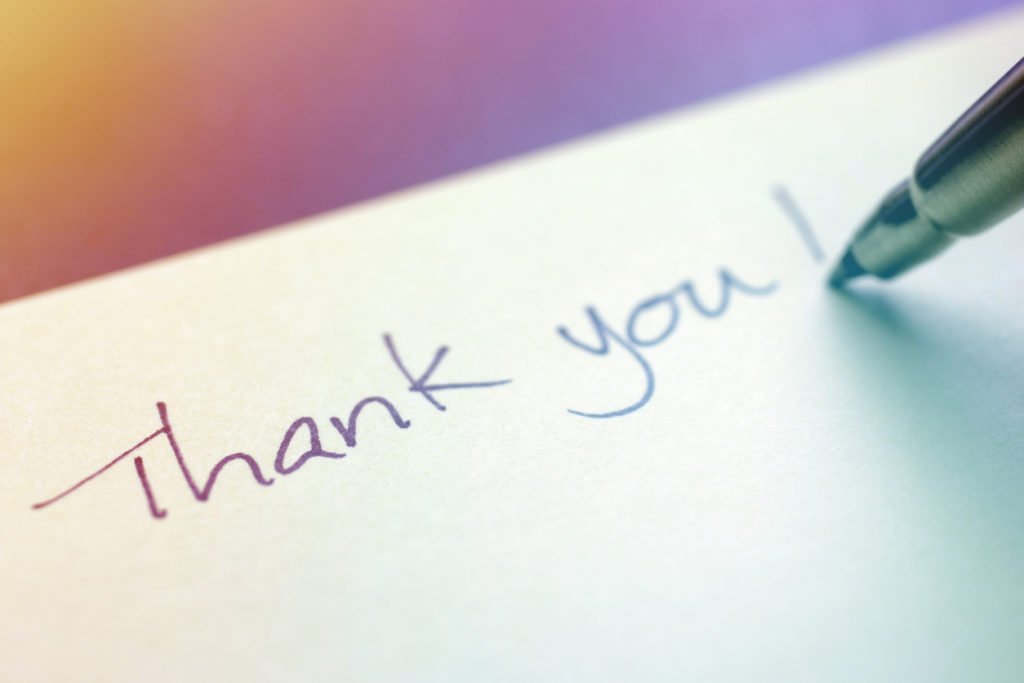
Several years ago, a colleague asked me to do an informational interview with a young woman who was thinking about getting into public relations. Happy to do this as a favor to a helpful colleague, I met with the young woman on a Saturday, answered her questions, and gave her the names of a few others to contact. I never heard from her again.
The thank you, it seems, is becoming a lost art. Maybe the young woman didn’t know she should follow up with a thank you note. But I was offended at what I perceived as a lack of consideration and a sense that she had taken me and my time for granted.
Thank you. These are two of the most powerful—and under-used—words in business. When I was growing up (as my 20-something children would say, “in the dark ages”) I was taught that when someone did something for you, you thanked them. Whether you receive a gift, get some advice, or dine at someone’s house, you drop a note to tell them how you appreciated their thoughtfulness and hospitality.
Those social rules may have been eroded, but they remain an important consideration. Even in the relentless pace of 21st century life, where no one feels they have time. Blame technology, the Internet, even a more relaxed culture. We too frequently overlook an expression of gratitude even though we are bombarded with lots of books and messages about the power of gratitude. We get it in the abstract but we don’t express it enough in daily life. A proper thank you still matters a great deal. In fact, it may even be something that sets you apart because so few people take the time and effort to offer thanks.
How do you say, “thank you,” and do it well?
Be authentic. First and foremost, you must be sincere in your appreciation. A pre-printed thank you card or perfunctory expression at the end of a conversation is better than nothing. But expressing thanks is so much more powerful when you sincerely express to someone how much their effort means to you or your business. How did their advice or good deed influence you, change your thinking, or simply inspire you?
Thank immediately. Don’t wait. Send the note or email within a week after you receive a gift, a card, a meal, or a team member’s extra time to get something done.
Thank often. If you are sincere in your appreciation, you can never say, “thank you,” enough. The thank you is a sign of respect and caring that is impossible to overdo.
Don’t delegate. Saying thanks is something you must do yourself. The kind deed or extra effort was done for you, not your assistant, not your spouse. Take ownership of your appreciation. And avoid form thank you notes where you fill in the blanks. That’s not just insincere. It’s tacky.
Best formats?
The handwritten note. If time is not of the essence, the handwritten thank you note is still the best way, especially when you invest in a nice card or stationery and put on your best penmanship. The note doesn’t have to be a novel, but it should, of course, thank the person for whatever they did. More importantly, it should talk about what their actions meant.
The thank you email. If you feel too time pressed or you have the nightmarish handwriting of Freddy Krueger (like I do), sending an email is the next best thing. The suggestions above still apply.
The thank you phone call. This is especially nice following a dinner at someone’s home. It is highly personal because you are having a conversation. Be authentic. Smile over the phone to warm up your voice. If you get voice mail or a machine, leave a thoughtful message.
To appreciate others is one of the most human things we can do. At this Thanksgiving and all year round, let’s remember to revive the art of saying thank you to those around us. And now I’ll practice what I preach. Thank you all my wonderful clients who inspire me and teach me so much. Thank you for my dedicated Wainger Group colleagues, Jan, Norma, Liza and Chiquita. Thank you to my friends who are always there for me. And thank you for my family who bring me such joy every day and keep me centered.
Happy Thanksgiving to all!

